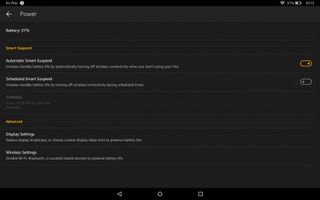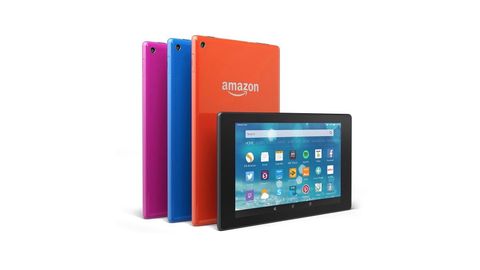Why you can trust TechRadar
One of the main criticisms of Amazon tablets in the past has been their software. FireOS simply hasn't been much cop for anything other than consuming Amazon content.
Fortunately, FireOS 5 on the Amazon Fire HD 10 and HD 8 is much improved, at least in terms of the interface design. It's been stripped back from its previous patronisingly zoomed-in carousel style, and it's now a little closer to the Android 5.1 OS that underpins it.

The home screen now shows several rows of installed apps, and you can scroll down to reveal more. Scrolling left and right, meanwhile, will take you to specific media sections for books, videos, games, apps, and more.
It's more reminiscent of the kind of media app you might find on your smart TV than a regular tablet UI, but it's reasonably intuitive.
What it isn't is fluid. I don't know if it's the new Amazon Fire HD range's limited hardware poke (both have the same mediocre MediaTek quad-core CPU and 1GB of RAM) or inefficiencies in FireOS 5's code – possibly it's a combination of both – but the experience is frequently laggy.
The three on-screen control buttons (another sign of Android peeking through) are often unresponsive, and trying to do anything else while downloading apps in the background is an exercise in frustration. Even waking the tablet from sleep seems to take half a second, which is half-a-second too long.
For all Amazon's efforts to make a distinctive tablet OS, FireOS is still inferior to plain Android, not to mention the iPad mini 2's iOS. And when that already sub-par OS performs as sluggishly as it does with the Amazon Fire HD 10 and HD 8 – well, it doesn't make for a great combination.

Elsewhere, performance is actually perfectly adequate. Step into an HD video stream or even a complex 3D game, and everything moves along at an appreciable pop, suggesting that this is indeed more of a FireOS issue than a hardware one.
I put both tablets through their paces with games of Real Racing 3, Dead Trigger 3, Monument Valley and Space Marshals – all graphically rich games in their own way – and the two tablets barely stuttered.
Of course, part of the reason for this creditable gaming performance is the Fire HD duo's poor screen resolution, which places less demand on the GPU, but still.
Putting them through the usual Geekbench 3 benchmark test I got very similar results from both, which is understandable given their identical hardware configuration. The average single-core score of 779 is about equal to the Hudl 2, but the 1506 multi-core score is a fair amount behind the Tesco tablet (which scored 2147) and the iPad mini 2 (at 2220).
All in all, the Amazon Fire HD family is arguably found most wanting here in the interface and performance category, which isn't a great situation to be in given the strength of the competition.
Battery
Battery performance on the Amazon Fire HD 10 and HD 8 is about par for the tablet course. Amazon claims eight hours of mixed use for both, which is the same as the Hudl 2, and my experience would suggest this is accurate.
Both tablets lasted through a day of moderate usage, but they're perhaps not the outright strong performers you might be hoping for when it comes to consuming media over protracted periods.

The regular techradar battery test involves running a 90-minute 720p video with the screen brightness cranked up to full. The HD 10 was left with 74% battery on average, while the HD 8, with its smaller battery, was left with 70%.
Both results are better than the Hudl 2, which could only manage 64%, probably due in part to its sharper display.
Ultimately, you'll be able to play a couple of full-length movies on both the Amazon Fire HD 10 and HD 8 and still have enough juice for a little light gaming and emailing – but that's really the least you'd expect from a media-focused tablet.
Current page: Interface and performance
Prev Page Screen and speakers Next Page Essentials, camera and media
